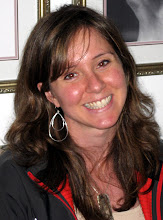 ... Just posted a new entry on the MacLeans.ca OnCampus Blog , on the merits of using case study pedagogy in the science classroom (image to the left shows some of my students working through a case study).
... Just posted a new entry on the MacLeans.ca OnCampus Blog , on the merits of using case study pedagogy in the science classroom (image to the left shows some of my students working through a case study).As I now have some time to update my blogs (having recently finished teaching a Molecular Biology course), you can soon expect some entries in this blog on biological topics... I plan to do a little piece on phage therapy, golden rice, and HIV/AIDS, three topics that generates lots of discussion in my classroom...
Coming soon!


2 comments:
My google alert on 'phage therapy' brought up your intention to write a piece on the subject. I have just recently retitled my talk on phage therapy in the series of presentations under the title: Happiness is getting beyond bullshit! (It includes a presentation on The Academics of Bullshit 101 - see http://bullshitcitynorth.blogspot.com ). I consider the way we have handled phage therapy during the last 10 years as an example of 'efficient redundancy' - instead of sending a few doctors and scientists to Georgia and Poland we are mapleleafing the field de novo - how green is that?
SUPERBUGS AND PHAGE THERAPY - GETTING BEYOND BULLSHIT UND UEBERBULLSHIT:
While 8000 to 12000 Canadians are dying from antibiotic-resistant superbug infections annually the joke is on us, as some countries still practice technology discovered by the Canadian, Felix d'Herelle in 1917. Phage therapy uses highly specific viruses, bacteriophages, which are harmless for humans, to treat bacterial infections. Phage therapy is not currently approved or practised in Canada. According to a letter signed by a former federal health minister it can be made available legally to Canadians under the Special Access Program of our Food & Drugs Act! A discussion of phage therapy is currently very timely because of the release of the Canadian film: Killer Cure: The Amazing Adventures of Bacteriophage and the book by Thomas Haeusler entitled, Viruses vs. Superbugs, a solution to the antibiotics crisis? ( see http://www.bacteriophagetherapy.info ). Both references are available at Ottawa libraries.
This file has dramatically changed because the US Food and Drug Administration has amended the US food additive regulations to provide for the safe use of a bacteriophages on ready-to-eat meat against Listeria monocytogenes (see http://www.fda.gov/OHRMS/DOCKETS/98fr/02f-0316-nfr0001.pdf ). Also http://www.cfsan.fda.gov/~dms/opabacqa.html . The idea that ready-to-eat meat can be treated for contamination with Listeria bacteria while a doctor could not get a pharmaceutical grade phage therapy product when faced with a patient suffering listeriosis strikes this author as absurd especially considering the recent massive recall of ready-to-eat meat in Canada due to contamination with listeria. Information is available on phage therapy treatment in Georgia , Europe ( http://www.phagetherapycenter.com ), or Poland - ( http://www.aite.wroclaw.pl/phages/phages.html ) or more recently at the Wound Care Center, Lubbock, Texas ( http://www.woundcarecenter.net/ ) .
For ethical reasons and to comply with World Medical Association guidelines ( Helsinki declaration 32) Canada should establish 'The Superbug Victim Felix d'Herelle Memorial Center for Experimental Phage Therapy' to provide phage therapy to patients when antibiotics fail or when patients are allergic to antibiotics.
Here is some more interesting stuff about phage therapy:
It is interesting that at least three religions have passages that can be reasonably be explained scientifically as eluding to a recognition of phage therapy. Islam has 'The Hadith of the Fly' and Christianity has 2 Kings 5:14 and of course, Hinduism has the story of the healing powers of the river, Gagna, which has been shown to teem with bacteriophages active against Vibrio cholerae. It is therefore not surprising that the scientific literature generally starts with a report by Ernest Hankin, a British bacteriologist, who reported in 1896 on the presence of marked antibacterial activity (against Vibrio cholerae) which he observed in the waters of the Ganges and Jumna rivers in India, and he suggested that an unidentified substance (which passed through fine porcelain filters and was heat labile) was responsible for this phenomenon and for limiting the spread of cholera epidemics.
While googling to verify the religious passages, I discovered that a recent play by Gautam Raja, 'The Invisible River' now explores the religious and scientific issues behind bacteriophage therapy and that this play was staged in England, at the Nehru Centre in London on July 16 and at Lillian Baylis Theatre in Sadler's Well on July 18 - this according to an article in The Hindu, June 22, 2008 entitled 'Invisible River' set to enthral U.K. audience'.
Phage therapy is an interesting case study where religion, science, the arts, journalists and in some places medicine, share the same place, while political, bureaucratic, Western medical and religious leaders, who should and could be promoting the reintroduction of phage therapy to medicine seem to be out to lunch between body counting!
Post a Comment